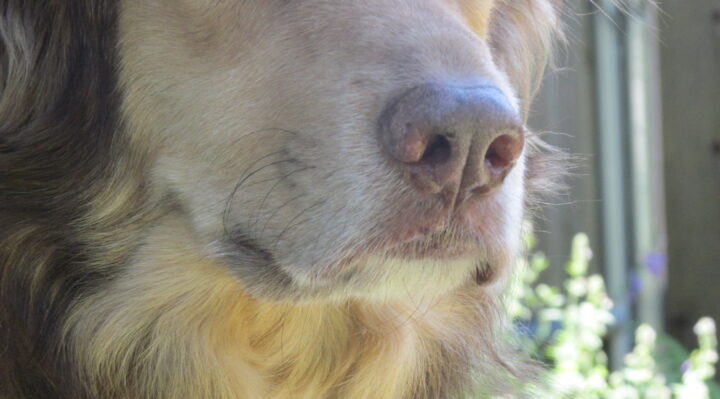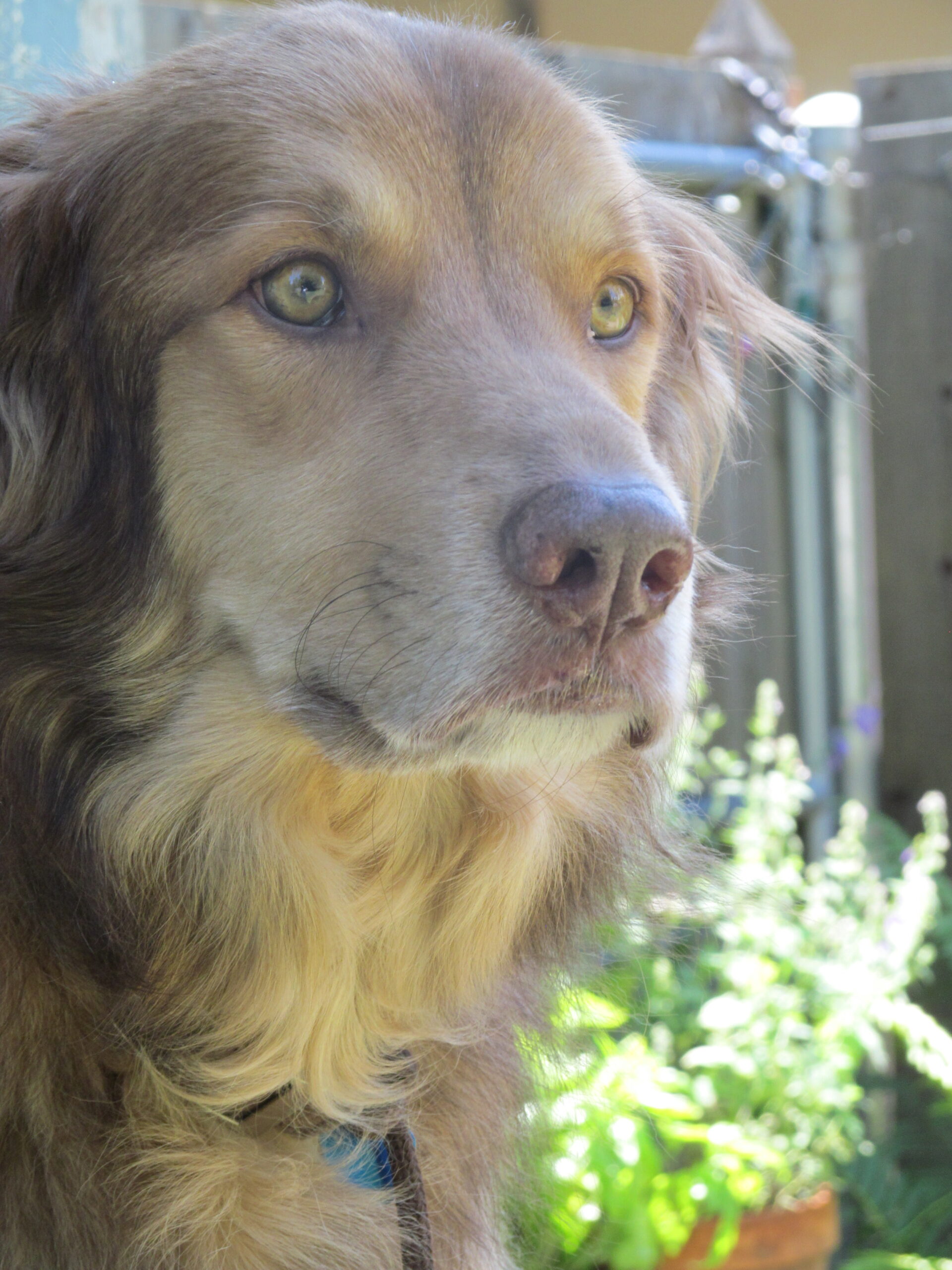
The last days of summer this year turned out to be something like a vacation for me. Not a trip away from home. Instead more like a trip back in time to before April, when my dog was diagnosed with CCD—Canine Cognitive Dysfunction, dog dementia.
He was calm, quiet at night, resting comfortably, no barking or other vocalizations, good sleeps for both of us. The weather had cooled and we were back in “our” room, him in his kennel (often by choice) or on ‘our’ bed. The restless behavior of a few weeks before had faded. He was more ‘himself,’ less symptomatic, than he had been since spring.

Photo by Val Hughes
I took advantage of this unexpected change, deciding to jump on a long overdue project now that it was cooler inside. A whole room to clean, including everything in it. Not a large room, but a room I saw every day, French doors away from “our” room. It’s the sunroom, with a wall of windows across the front of the house. No way to avoid seeing the dust that had settled deep there since the last time it was really tended to! Not disordered; just neglected.
I assembled the aids and products—static-free duster, cleaning sprays, Murphy’s oil soap for the hardwood floor, and … uh-oh. Of course. The vacuum cleaner, which had started to stress the dog about the time of his diagnosis. Was the vacuum cleaner going to be a problem?
It was not.
This time, my dog’s response to the vacuum’s being used in a room two feet away from where he was resting was reasonable … which turned out to be typical of his choices in the next few days of a project that lasted more than a weekend. I heard myself explaining to him why using the vacuum was necessary for a thorough cleaning. I can’t say that he ‘understood’—how would I know? But he sure seemed to get with the program, instead of stressing out.
I left his options open, and the door to leave the room, too. He did not stress—he exited.
At first, I’d ‘inform’ him each time I was about to turn the vacuum on, and I’d encourage him to “go downstairs”—words which I believe he does understand, as I’ve used them all his time here in this house. The baby gate was set aside. He was free to go … and he went.
Downstairs, he could check the kitchen, have a drink, sniff around for crumbs of dog crackers/food I had spilled or, as he eventually most often decided, he could hang out in his favorite ‘downstairs’ spot, looking out the front-door window at our front yard and the street. I know he’d snooze after a while, on the floor by the front door—I snuck down several times and saw him there.
He was relaxed and comfy.
He’d come back upstairs when the vacuum sound stopped, to check on my progress then to reassume his position on the bed, back to sleep within minutes. While I was dusting quietly.
It felt like the good old days.
It became routine as I continued the cleaning. He seemed to note the indications that vacuuming was about to begin (the placing of it, the plugging it in). He’d rouse and leave—not fearfully. His attitude was more like, “I’ve got this handled. I’ll be back when you’re done.” And he did come back, every time the vac had stopped for several minutes. I never had to call him. How did he know?
He observed and he predicted. He did get it.
I was so glad.
It doesn’t sound like much, does it? A dog cooperating while his human completes a long-neglected project at home? A dog, still the primary focus of the human while the work is being done, becomes a part of the process, which helps the human very much. Lots of breaks outside, work stops for needed naps, good snacks, and meds on time—the dog and human both sleeping well at night and waking rested. The human is happy because much-needed work is being done and done well. A sense of accomplishment felt rarely in days before. How did it happen?
Again, I don’t know. If you’d asked me that question at the time, I would have answered, “I think we’re getting used to it—the situation, the dog’s condition, the human’s reaction—together.”
So what’s been happening with the giving of the medication and the dog’s part of that equation? The change in that process may back up my opinion that we are getting used to it together. It was all my sister’s fault … and that’s a good thing.
My sister and I were talking on the phone recently and I commented that I couldn’t understand why the dog still seemed so eager to eat the meals that followed the nightly “pilling” and the struggle we had—more emotional than physical—every time I gave him medication. My thought was that it was odd he’d be so enthusiastic about a meal directly after the “pilling” conflict.
For me, the second I knew the meds were down his throat, it was a dirty job completed. For the dog, though, it was a sudden turnaround from resistance to a happy, eager “Yes!” to my question, “How about some yummy dinner?” Wagging tail, a rush to his bowl, impatient actions as I scooped his meal out of the can, then diving into it, nose in the bowl until the bowl was empty … and a positive response when I’d ask, “More? You want more?” He eats it all, every day now. He eats and asks for more.
How was he ‘forgiving’ me so easily for the pilling?
Why did he not ‘hold a grudge’?
My sister said, “It’s a reward.”
The meal, I wondered? That’s what she meant: the meal was, to the dog, a reward for the pilling. It sounded simple. It probably was. I can’t explain in scientific terms; I’m not that knowledgeable. I can say that this simple thought somehow changed my way of thinking about the situation which, I suspect, may have changed my way of acting about the situation.
I stopped dreading the pilling.
I had faced it as a physical challenge—to get the meds down his throat completely, with the least amount of force possible, not getting myself injured in the process. (Remember, he had lost much bite inhibition.) With the simplest explanation from my sister, pilling my dog no longer seemed so emotionally difficult for me. It was a job to complete successfully, not an act of aggression. It was the care that my dog needed. This daily act became much easier—for me and, I’m happy and surprised to say, apparently for my dog, too. Again, I don’t know how.
He stopped resisting the pilling.
I won’t say that made it easy, but I can say that made it easier. Shoving pills down a dog’s throat so far that he has to swallow them is never going to be easy. But in this case, I think the dog’s not resisting may have made the job easier on him, too. Not closing down his teeth around that human hand (mine!) is behavior that, if I may be presumptuous, I’d say is far more natural for him than struggling. It’s behavior that is my dog as he has always been, in my opinion.
He’s a gentle soul still.
I know what’s happening now may not last. I know no human’s hand is ever ‘safe’ completely in a dog’s mouth. And my dog has CCD; that’s not going away. His behavior could change in an instant … and it will never be ‘his fault.’
Is my behavior (and how I think about his) making a difference for both of us?
I think it is.
I’ll tell you more about how we’re doing in my next report—if I can still type with all my fingers. (Just kidding, of course!)
Thanks again for your interest and support.



